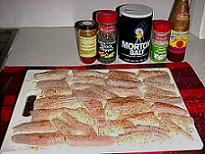Cooking Fish -- the preparation
by: Mike Picou
Fishing Texas
Network
Tips:
I happen to feel that the most important part of
cooking fish is the preparation that leads up to the cooking. Taking the time and the effort before it
hits the pan makes the end result something that you and whomever is eating it
will eagerly anticipate the next time you cook it.
From the water to the freezer
As awful as it sounds, I prefer to clean my fish
alive. There are several species of
fish which secrete an oily substance into the meat when they die. This oil is extremely difficult to
remove. If this occurs, it is best to
rinse the fillets thoroughly under cold water with relatively firm
pressure.
If I know that I cannot keep the
fish alive until filleting, I put them on ice and keep them very cold. It is also important to keep the fish from
being submerged in ice water. The ice
water is not as cold and tends to saturate the fish.
I like to fillet all the fish I keep. Unless it is rainbow trout – my wife likes those on the bone. I use an electric knife and travel the blade as close to the backbone as possible from the head to the tail -- leaving a small amount still attached to the tail. Flip the fillet over and run the blade down the under side of the skin. From here, I trim out the ribcage by cutting as close to the rib bones as possible. I then remove any of the meat that was attached to the fins – this is very strong, oily meat. Lastly, I check for any bones and remove them as necessary.
The last thing I do before I put my
fish in the freezer is to rinse them and remove any blood, scales, or remaining
fin meat. I place a meals worth in a
Ziploc bag and fill the bag with water.
I remove as much air from the bag as I possibly can before sealing
it. Usually, I label the bag with the
type of fish, number of fillets, and date caught.
From the
freezer to the pan
I like to thaw my fish out in the sink. I will fill the sink up halfway and place the sealed bag in the water – refresh the water occasionally and do not use hot water.
Once the fish is thawed, I will cut up the fish into a minimum of 4 pieces. This allows me to remove all the red meat from the fillet. This red meat also gives an oily taste to the fish. I also like to make sure that my fish pieces are not wider than about an inch, 3 or 4 inches long, and no more than half an inch thick. These pieces cook up quickly and each bite will have whatever seasoning you use.


Now… The fish is ready to cook….